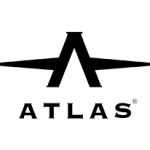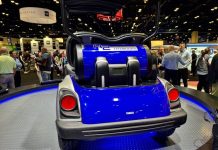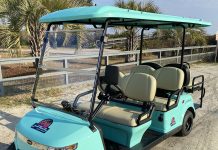PLEASE NOTE: Golf Cart Laws may vary from City to City, so please be sure to check with your local municipality in regards to the laws in your area. We are in the process of gathering laws by municipality for you, however, this is a huge undertaking and does take time. Thank you.
This is an in-depth guide to California Golf Cart & Low-Speed Vehicle Laws. We’ve created this guide to help you, the consumer, in determining California’s laws.
Is this state Medium Speed Vehicle friendly? No State Law is Currently in Place.
Is License and Registration a Requirement? For LSVs, yes. For Golf Carts, if it’s a designated Golf Community, no. Otherwise, yes.
General Federal Law for Golf Carts:
Under current NHTSA interpretations and regulations, so long as golf cars and other similar vehicles are incapable of exceeding 20 miles per hour, they are subject to only state and local requirements regarding safety equipment. However, if these vehicles are originally manufactured so that they can go faster than 20 miles per hour, they are treated as motor vehicles under Federal law.
The standard requires low-speed vehicles to be equipped with headlamps, stop lamps, turn signal lamps, taillamps, reflex reflectors, parking brakes, rearview mirrors, windshields, seat belts, and vehicle identification numbers.
Find out more information on federal laws pertaining to golf carts and low speed vehicles here.
California Golf Cart & Low Speed Vehicle Laws
Guidelines for Golf Carts and PTVs (Personal Transportation Vehicles)
Golf Cart Designated Communities:
In California, a community can be designated as a Golf Cart Community without requiring the vehicle to meet Federal Law as indicated by the State of California. If a golf cart is to be used in a golf cart community, then it must have the following:
- headlights
- turn signals
- rear view mirror
- side mirrors
- brake lights
- windshield
The community will designate whether the golf cart requires a covered passenger compartment and seat belts. The top speed for a golf cart is also designated by the community but will not exceed 25 MPH.
Guidelines for LSV (Low Speed Vehicle)
- Has four wheels.
- Within one mile can reach a speed of more than 20 miles per hour (mph) but not more than 25 mph on a paved level surface.
- Has a 17-digit conforming vehicle identification number (VIN)
- Has a gross vehicle weight rating (GVWR) of less than 3,000 pounds.
- Must be certified to meet Federal Motor Vehicle Safety Standards (FMVSS) to be registered and operated on public streets, roads, or highways.
- Not be operated on any roadway with a speed limit above 35 mph.
- Cross state highways only at controlled intersections. Crossing at uncontrolled intersections is permitted with approval of the local authority governing that intersection.
- Cross at intersections that have a speed limit above 35 mph, if the crossing begins and ends on a road of 35 mph or less.
- Be operated as a golf cart within a distance of one mile or less from a golf course or on roads designated for such operation by ordinance or resolution by a local authority.
LSVs may look like a golf-cart to the casual observer, but is actually a motor vehicle requiring a valid California driver license, registration, and insurance.
For more info, please go to the official DMV website for California HERE.
HELPFUL LINKS
GOLF CART DEALERS IN CALIFORNIA (VIEW ALL)
Disclaimer
Although each of these state guides gives a thorough approach to the golf cart laws in your state, it is recommended that you perform the research on your own and reach out to your local municipality.
Recent News & Helpful Articles












